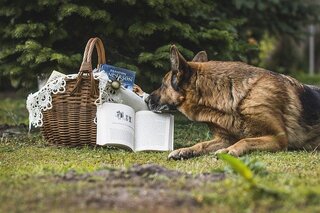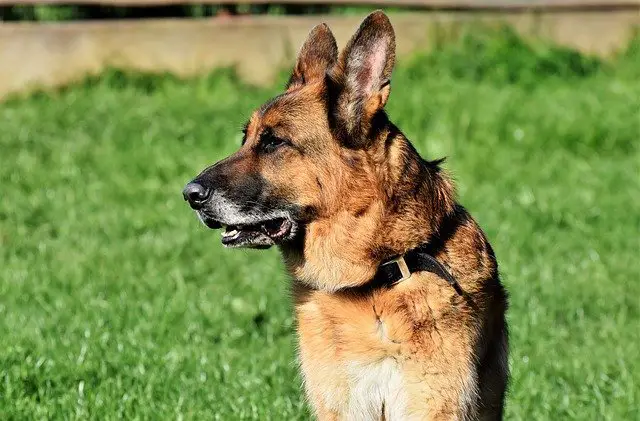The German shepherd is a medium to large breed of dog whose popularity is ranked number two in the USA, behind the Labrador retriever.
That is quite impressive! German shepherds make wonderful family dogs and because of their personality and temperament, they have been used, over the years,
as working dogs, with military and police, for search and rescue, and as service dogs for the disabled, especially the visually impaired If you are considering adding a German shepherd to your family, look no further.
Below, you will find all of the information you need, such as the average lifespan of a German shepherd is and all about the German shepherd’s temperament.

History of The German Shepherd.
The German shepherd once called the Alsatian, originated in the 19th century, in Europe where Europeans were beginning to breed dogs to suit their needs. Dogs were not domesticated like today but were needed for work.
Farmers in Germany needed dogs for herding and keeping their sheep together as well as for protection against wolves.
They required a breed that was intelligent, strong, protective, and possessed the stamina for herding.
Max Von Stephanitz was looking for such a dog to fit the bill for this special working dog, and in 1899 he found this dog at a dog show.
The dog was magnificent, and large, and embodied everything he desired for the herding dog of his dreams.
He bought Horand who became the first German shepherd. Horand was used in breeding almost one hundred dogs and his son Hektor had a total of eighty-four offspring.
German shepherds became popular after WWI, when soldiers, returning from the war told stories of this amazing breed who was valiant and strong, yet loyal and friendly.
After the second world war, the German shepherd’s popularity fell, especially in the USA with tension and anger high over the Nazi’s atrocities and reign over Europe, being that they carried the German name.
By the 1960s, the German shepherd once again soared in popularity and remains at the top of the list today. Many famous German shepherds have come and gone like Rin Tin Tin, who starred in television and movies.
Today, thanks to one German shepherd, a guide dog school is still up and running and over ninety years old.
In 1928, a man named Morris Frank, who was blind since the age of sixteen, received the first seeing-eye dog, named Buddy.
He had worked with Buddy when he traveled to Switzerland, meeting Dorothy Eustis, an American who had a training and breeding facility there and had German shepherds trained for police work.
In 1929, Dorothy and Morris founded the first school for guide dogs in Nashville, Tennessee. The school relocated to Whippany, New Jersey in 1930,
and in 1965 again relocated to a sixty-acre campus in Morristown, New Jersey, where it remains today, giving independence to the visually impaired.
This school is known as The Seeing Eye. There are residences for students, kennels, and a veterinary clinic on campus.
The kennels are needed because the facility breeds its own dogs, Golden retrievers, Labrador retrievers, and golden Labs, for information about retrievers dogs visit the link retrieverdogsite.com, and of course, German shepherds.
These dogs are hard workers, selfless humanitarians, and ambassadors for the visually impaired, allowing them to have a life of dignity and independence.
To check your shepherds’ health status or their DNA checks, please visit the Embark vet website for all the help you may need.

For your dog’s vitamin supplement, food, toys, or other dogs product please visit the Sundays for dogs
German shepherds Appearance
German shepherds are quite an impressive breed, being very muscular and powerful, with some being exceptionally large.
Females can weigh from 50lbs to 70lbs, while males may weigh in at 65lbs to 95lbs. The height of the females can be 22 inches to 24 inches and for males, 24 inches to 26 inches. They are mostly long in body than tall.
The shepherd has a double-thick coat with an undercoat for insulation and an overcoat for protection against the elements.
This coat does require quite a bit of attention and grooming as they do shed all year but lose their undercoat twice a year, in spring and fall.
This can be a hefty amount of fur which requires plenty of brushing. They also have long bushy tails.
The German shepherd is well known for its black and tan coloring but can be sable or all-black as well. There are pure white shepherds but they are known as the white shepherd and are a separate breed in some countries.
The shepherd is endowed with strong jaws and a long muzzle. Their eyes are brown and they have black noses and erect ears.
German shepherds are quite solid and sturdy with a large chest, always agile but never clumsy for their size.
German shepherd Temperament
The German shepherd’s temperament is evident in the herding instinct they possess. They have a very strong pull on the herd which may show up in family life as they may, at times, gently try to “herd” family members.
They are a member of the herding breed group and are in good company joined by the Belgian Malinois, Australian cattle dog and shepherd, the Belgian sheepdog, and the border collie, just to name a few.
The German shepherd’s temperament and personality are intelligence, obedience, watchfulness, and observance.
They are also curious, alert, and loyal, especially to family. Because of their guarding and herding instincts and ability, they can sometimes be overprotective of territory and family.
German shepherds need to become socialized with different people and dogs as a puppy to avoid this as it can sometimes lead to aggression, especially towards strangers.
The German shepherd is easy to train as they revel in purpose and are eager and willing to learn, being focused, confident and fearless.
Training is very much needed for the shepherd and given their size you must assume the role of pack leader, the one in charge. Obedience training can help with this and an obedient well-mannered pup will be the outcome.
German shepherds are also very active and need plenty of exercise as well as mental stimulation with games and toys.
Without this, they can become bored and resort to chewing and other unwanted behaviors. They do love their family and are prone to separation anxiety, another reason for lots of exercises. This will avoid destructive behavior.
Health
You can do the most important thing when considering a German shepherd and a healthy one is to seek out a reputable breeder, speak with them, visit their facilities, and ask questions.
German shepherds have a predisposition to some health problems and many are due to improper breeding and caused by genetics.
Hip and elbow dysplasia are two of the most common genetic problems shepherds suffer from. These are congenital issues that can be quite painful and severe.
Good breeders ensure that neither parents carry this gene before breeding by genetic testing.
Some other health problems of the German shepherd are allergies, pancreatitis, epilepsy, hypothyroidism, osteoarthritis, and dental issues, the last of which can lead to some severe health conditions.
The average lifespan of a German shepherd is from nine to thirteen years and this is just an average not a definite. Every dog is an individual, thus their health is different from that of other dogs too.
Making sure your German shepherd is in the best of health begins as a puppy to ensure a long and robust life.
German shepherds need high-quality dog food with just the right amount of protein, good carbohydrates, good fats, and necessary vitamins, minerals, and nutrients to keep them active. Regular veterinary visits are essential to ensure good health as well.
By checking in with their vet, you can be sure they are growing properly, just the right weight, receiving proper nutrition, and identifying any health issue early so it can be treated.
Exercise
Exercise is also essential to guarantee a long life. Exercise keeps everyone in the family healthy and your pup too.
Grooming
Grooming is another need to remain healthy. Bathing and brushing keep their skin and fur healthy and eliminate any parasites as well.
Brushing your pup’s teeth is a big one because teeth with a buildup of plaque and tartar can cause decay and eventually gum disease which in turn can snowball into health issues, the cardiac disease being one. is another need to remain healthy.
Bathing and brushing keep their skin and fur healthy and eliminate any parasites as well. Brushing your pup’s teeth is a big one because teeth with a buildup of plaque and tartar can cause decay and eventually gum disease which in turn can snowball into health issues, the cardiac disease being one.
Training
Training also is essential for a long healthy life. A properly trained German shepherd is a dream on leash and off if taught to come when called. This can avoid very unfortunate accidents.
Socialization
Socialization and mental stimulation for a well-mannered, well-rounded and fulfilled life for your German shepherd is also imperative.
German shepherds, when properly trained and cared for make excellent family dogs and companions.
They can do anything you want them to do from jogging with you, hiking with your family, playing with children, and hanging out with seniors with their calm and gentle nature.
Adding a German shepherd to your family is an excellent plan. Be sure to research your breeder of choice and you’ll have a shepherd as a companion and family member for many years to come
